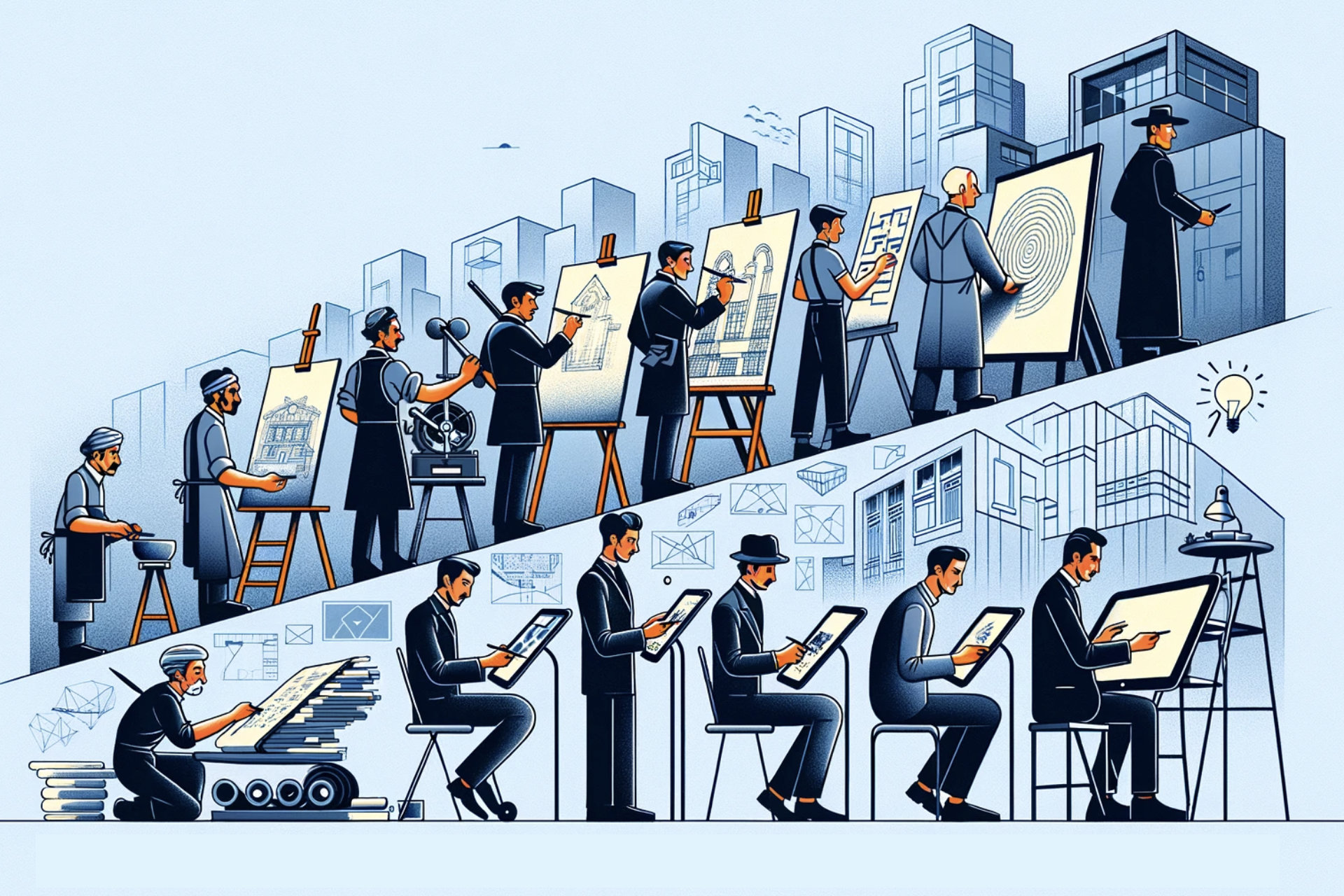The Evolution of Modern Design: 5 Huge Transformative Phases

Design, like all forms of art, is ever-evolving. It reflects societal shifts, technological advancements, and cultural influences.
From the handcrafted works of the Arts and Crafts Movement to the digital masterpieces of today, the evolution of modern design has been a captivating journey.
This article delves into this evolution, highlighting key milestones and the role of technology in shaping contemporary design.
Inside this Article
Introduction to Design History
The transformation of design over the centuries is profound. Cultural shifts, along with technological advancements, have continually shaped the evolution design concept.
From hand-drawn illustration sketches to sophisticated digital renderings, design has always mirrored the zeitgeist of its era.
Key Milestones in Design Evolution
The Arts and Crafts Movement (Late 19th Century):
Emerging as a reaction against the mechanization of the Industrial Revolution, the Arts and Crafts Movement celebrated the beauty of handcrafted goods and decorative patterns.
During this time, the evolution design packaging gravitated towards detailed and intricate designs, underscoring the value of craftsmanship over impersonal mass production.
The Bauhaus School (Early 20th Century):
The Bauhaus School was nothing short of revolutionary. Marrying art, craft, and technology, it heralded a design ethos where functionality reigned supreme over excess ornamentation.
This approach laid the foundation for the design principles that modernism would later embrace.
Mid-Century Modern Design (Mid-20th Century):
Characterized by its streamlined forms, organic shapes, and a pronounced focus on function, the mid-century modern design movement mirrored the technological advancements and optimism that followed World War II.
Design during this era was not just about aesthetics but also about catering to the practical needs of a post-war society.
Postmodernism (Late 20th Century):
Postmodernism marked a deliberate and bold departure from the austerity of modernist ideals. It was an era of vibrant colors, a mix of historical references, and a playful take on design elements.
Designers began to create eclectic pieces, drawing inspiration from a myriad of eras and cultures.
Digital Revolution (Late 20th – Early 21st Century):
The era of the digital revolution signified a profound transition from print to pixel. Personal computers, design software, and digital platforms became indispensable tools for designers.
This shift emphasized the need for adaptability in various design spheres, including evolution outdoor design, where the blend of physical and digital spaces became more pronounced.
Evolution Design Services (21st Century):
With the dawn of the 21st century came a notable shift in how design services were offered and consumed. The traditional model of project-based design services started giving way to more flexible, on-demand models.
Agency like Triplegrowth led the way, offering unlimited design services tailored to the dynamic needs of businesses. Such on-demand design agencies have redefined the landscape, ensuring businesses have continuous access to top-notch design without the constraints of traditional service models.
The Role of Technology in Shaping Design Trends
The transition from pencils and papers to styluses and screens has been monumental. The rise of design software, such as the Adobe Suite, revolutionized the evolution design concept. Tools like Photoshop and Illustrator democratized design, allowing more people to explore their creativity.
Furthermore, the internet and digital platforms have made design more accessible, fostering global collaboration and sharing. The emphasis on mobile technology has also shaped the evolution of responsive design, ensuring designs look impeccable across all devices.
Case Studies: Companies that Have Adapted and Thrived
Apple
Apple’s design journey from the Apple I to the sleek, modern designs of the MacBook and iPhone showcases its adaptability. With a constant emphasis on user experience and interface design, Apple has remained at the forefront of the evolution design concept.
IKEA
Bringing Scandinavian design to the masses, IKEA has struck a balance between affordability and design. Their evolution design packaging is iconic, blending functionality with aesthetics. Moreover, IKEA has managed to adapt to global markets while maintaining a consistent design language.
Adobe
Adobe’s transition from boxed software to cloud-based solutions is a testament to its adaptability. By providing tools that cater to the evolution design services, Adobe has played a pivotal role in shaping the modern design landscape.
The Future Evolution of Modern Design
The journey of design, from its conceptual stages to its current digital revolution, is a testament to its ever-evolving nature.
As technology continues to advance and societal needs shift, the evolution of modern design will remain an ongoing, captivating journey.
As designers, being aware of this evolution ensures that our work remains relevant, innovative, and in tune with the times.
What is the evolution of modern design?
The evolution of modern design traces the transformative journey of design principles and aesthetics from historical movements like the Arts and Crafts and Bauhaus School to the digital revolution of the 21st century. It encompasses shifts in technology, culture, and societal needs, leading to the diverse design landscape we see today.
How has technology impacted the evolution of modern design?
Technology has played a pivotal role in the evolution of modern design. From the introduction of design software and tools to the rise of digital platforms and on-demand design services, technological advancements have not only changed the tools designers use but also the way they think, collaborate, and create.
Which design movements are pivotal in the evolution of modern design?
Several design movements have significantly influenced modern design. Key movements include the Arts and Crafts Movement, the Bauhaus School, Mid-Century Modern Design, Postmodernism, and the ongoing Digital Design Revolution. Each has left a distinctive mark on design principles and aesthetics.
Why is understanding the evolution of modern design important for designers?
Grasping the evolution of modern design offers designers insights into past trends, mistakes, and successes. It provides a foundation for innovation, ensuring that designers create relevant, functional, and aesthetically pleasing designs that resonate with contemporary audiences while also pushing the boundaries of what’s possible.